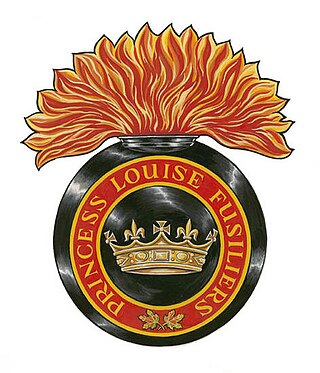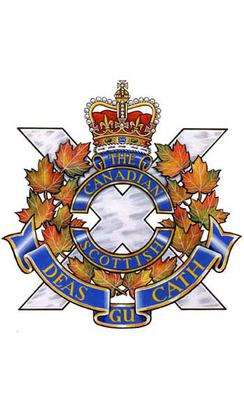History
Early history
On 22 March 1872, the 62nd St. John Battalion of Infantry was authorized for service. [1]
On 14 April 1882, the battalion was Redesignated as the 62nd Battalion Saint John Fusiliers. [1] [2]
South African War & Early 1900s
During the Boer War, the 62nd St. John Fusiliers contributed volunteers for the various Canadian Contingents serving in South Africa. [2]
On 8 May, 1900, the 62nd Battalion Saint John Fusiliers was Reorganized and Redesignated as the 62nd Regiment, St. John Fusiliers. [1]
The Great War
On 6 August 1914, Details of the 62nd St. John Fusiliers were placed on active service for local protective duty. [2]
On 7 November 1914, the 26th Battalion, CEF was authorized and on 15 June 1915, the 26th Battalion embarked for Great Britain. [2] On 16 September 1915, the 26th Battalion disembarked in France where it fought as part of the 5th Canadian Infantry Brigade, 2nd Canadian Division on the Western Front until the end of the war. After its return to Canada, on 30 August 1920, the 26th Battalion was disbanded. [2]
On 22 December 1915, the 115th Battalion, CEF was authorized and on 23 July 1916, embarked for the UK. [2] The battalion provided reinforcements for the Canadian Corps in the field until when on 21 October 1916, its personnel were absorbed by the 112th Overseas Battalion, CEF. On 1 September 1917, the 115th Battalion was disbanded. [2]
1920s–1930s
On 15 March 1920, as a result of the Otter Commission and the following post-war reorganization of the militia, the 62nd Regiment, St. John Fusiliers was Redesignated as The St. John Fusiliers and was reorganized with 2 battalions (1 of them a paper-only reserve battalion) to perpetuate the assigned war-raised battalions of the Canadian Expeditionary Force. [1] [3] [4]
On 2 September 1925, the regiment was Redesignated as The Saint John Fusiliers. [1]
On 15 December, 1936, The Saint John Fusiliers were amalgamated with the New Brunswick Dragoons and "A" Company of the 7th Machine Gun Battalion, CMGC and renamed as The Saint John Fusiliers (Machine Gun) as they were re-tasked as an Infantry Battalion (Machine Gun) as a result of the 1936 Canadian Militia Reorganization. [3] [5] [6] [7] [8]
Second World War
On 26 August 1939, details of The Saint John Fusiliers (Machine Gun) were called out on service, and then on 1 September 1939, they were placed on active service as The Saint John Fusiliers (Machine Gun), CASF for local protection duties. [2] On 31 December 1940, the details called out on active service were disbanded. [2]
On 1 January 1941, the regiment mobilized the 1st Battalion, The Saint John Fusiliers (Machine Gun), CASF for active service. The battalion served in Canada in a home defense role as a part of the 18th Canadian Infantry Brigade which was the first part of Pacific Command and then the 6th Canadian Infantry Division . [2] [9] [10]
From 16 August 1943 to 6 January 1944, the Battalion's "C" Company took part in the expedition to Kiska, Alaska as a component of the 13th Canadian Infantry Brigade Group. [2]
On 2 January 1945, the battalion embarked for the UK and upon arrival was disbanded to provide reinforcements to the First Canadian Army on 10 January 1945. [2]

The Princess Louise Fusiliers is a Primary Reserve light infantry regiment of the Canadian Armed Forces. Formed as 66th The Halifax Battalion of Infantry and then named 66th Battalion after Princess Louise in 1879, it took its present name in May 1920. The 6th Machine Gun Battalion, CMGC amalgamated with the regiment in 1936

The Canadian Scottish Regiment (Princess Mary's) is a Primary Reserve infantry regiment of the Canadian Army based on Vancouver Island in British Columbia.

The Highland Light Infantry of Canada was an infantry regiment of the Canadian Army. In 1965, the regiment was amalgamated with The Scots Fusiliers of Canada to form The Highland Fusiliers of Canada.
The Winnipeg Light Infantry was an infantry regiment of the Non-Permanent Active Militia of the Canadian Militia. In 1955, the regiment was amalgamated with The Royal Winnipeg Rifles.
The Edmonton Fusiliers was an infantry regiment of the Non-Permanent Active Militia of the Canadian Militia and later the Canadian Army. First raised in 1908 as part of the 101st Regiment Edmonton Fusiliers, it became a separate regiment in 1924 when The Edmonton Regiment was split into two separate regiments. In 1946, the regiment was Amalgamated with the 19th Alberta Dragoons.
The Canadian Fusiliers (City of London Regiment) was an infantry regiment of the Non-Permanent Active Militia of the Canadian Militia (now the Canadian Army). In 1954, the regiment was amalgamated with The Oxford Rifles to form The London and Oxford Fusiliers (now the reserve battalion of the Royal Canadian Regiment).
The New Brunswick Rangers was an infantry regiment of the Non-Permanent Active Militia of the Canadian Militia. In 1946, the regiment was amalgamated with The Saint John Fusiliers to form The South New Brunswick Regiment which was later renamed as The New Brunswick Scottish. They now form part of the 1st Battalion, The Royal New Brunswick Regiment.
The Saskatoon Light Infantry was an infantry regiment of the Non-Permanent Active Militia of the Canadian Militia. The regiment was formed in 1924, when The North Saskatchewan Regiment (1920–1924) was reorganized into four separate regiments. In 1955, the regiment was amalgamated with The Prince Albert and Battleford Volunteers to form The North Saskatchewan Regiment.
The Oxford Rifles were an infantry regiment of the Non-Permanent Active Militia of the Canadian Militia. In 1954, the regiment was amalgamated with The Canadian Fusiliers to form The London and Oxford Fusiliers.
The New Brunswick Dragoons was a cavalry regiment of the Non-Permanent Active Militia of the Canadian Militia. In 1936, the regiment was Amalgamated with The Saint John Fusiliers.
The Peterborough Rangers was an infantry regiment of the Non-Permanent Active Militia of the Canadian Militia. In 1936, the regiment was amalgamated with the 3rd Prince of Wales' Canadian Dragoons to form The Prince of Wales Rangers.
The Haldimand Rifles was an infantry regiment of the Non-Permanent Active Militia of the Canadian Militia. In 1936, the regiment was Amalgamated with The Dufferin Rifles of Canada to form The Dufferin and Haldimand Rifles of Canada.
The Dufferin and Haldimand Rifles of Canada was an infantry regiment of the Non-Permanent Active Militia of the Canadian Militia and later the Canadian Army. The regiment was formed in 1936, when The Haldimand Rifles was Amalgamated with The Dufferin Rifles of Canada. In 1946, the regiment was converted from Infantry to Artillery and now forms part of the 56th Field Artillery Regiment, RCA.
The Northumberland Regiment was an infantry regiment of the Non-Permanent Active Militia of the Canadian Militia. In 1936, the regiment was amalgamated with The Durham Regiment to form The Midland Regiment.
The Durham Regiment was an infantry regiment of the Non-Permanent Active Militia of the Canadian Militia. In 1936, the regiment was Amalgamated with The Northumberland Regiment to form The Midland Regiment.
The Sherbrooke Regiment was a regiment of the Canadian Militia and later the Canadian Army Reserve that existed from 1866 to 1965. Originally an infantry regiment, during the Second World War the regiment helped form the 27th Armoured Regiment (The Sherbrooke Fusilier Regiment) which served as an armoured (tank) unit in the 2nd Canadian Armoured Brigade. In 1946, the regiment itself was converted to an armoured regiment was redesignated as The Sherbrooke Regiment (RCAC). In 1965, the regiment was amalgamated with the 7th/11th Hussars to form The Sherbrooke Hussars.
The Cumberland Highlanders was an infantry regiment of the Non-Permanent Active Militia of the Canadian Militia. In 1936, the regiment was amalgamated with The Colchester and Hants Regiment to form The North Nova Scotia Highlanders.
The Colchester and Hants Regiment was an infantry regiment of the Non-Permanent Active Militia of the Canadian Militia. In 1936, it was amalgamated with The Cumberland Highlanders to create The North Nova Scotia Highlanders.
The Middlesex and Huron Regiment was an infantry regiment of the Non-Permanent Active Militia of the Canadian Militia. It was formed in 1936, as a result of the Amalgamation of The Middlesex Light Infantry and The Huron Regiment. In 1946, the regiment was disbanded.
The Midland Regiment was an infantry regiment of the Non-Permanent Active Militia of the Canadian Militia and later the Canadian Army. The regiment was formed in 1936 by the Amalgamation of The Northumberland Regiment and The Durham Regiment. In 1954, The Midland Regiment was amalgamated into The Hastings and Prince Edward Regiment.
This page is based on this
Wikipedia article Text is available under the
CC BY-SA 4.0 license; additional terms may apply.
Images, videos and audio are available under their respective licenses.

